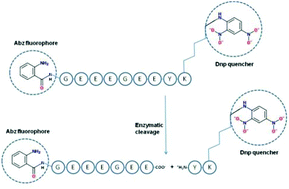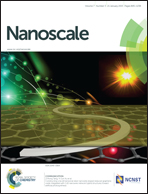A novel biosensor for quantitative monitoring of on-target activity of paclitaxel†
Abstract
This study describes a system for quantifying paclitaxel activity using the C-terminus of α-tubulin as a biomarker. Following stabilization of microtubules with paclitaxel, a specific detyrosination reaction occurs at the C-terminus of α-tubulin which could be used to assess efficacy. A fluorescence resonance energy transfer (FRET) based biosensor was synthesized comprising a short peptide that corresponded to the C-terminus of α-tubulin, a fluorophore (Abz), and a quencher (Dnp). The fluorophore added to the end of the peptide can be released upon enzymatic detyrosination. In addition, a single fluorophore-tagged peptide was also conjugated to mesoporous silica nanoparticles to examine the feasibility of combining the drug with the peptide biomarker. As a proof of concept, we found that the degree of peptide cleavage, and therefore enzymatic activity, was directly correlated with exogenous bovine carboxypeptidase (CPA) an enzyme that mimics endogenous detyrosination. In addition, we show that cell lysates obtained from paclitaxel-treated cancer cells competed with exogenous CPA for biosensor cleavage in a paclitaxel dose-dependent manner. Our work provides strong evidence for the feasibility of combining paclitaxel with a novel biosensor in a multi-load nanoparticle.


 Please wait while we load your content...
Please wait while we load your content...